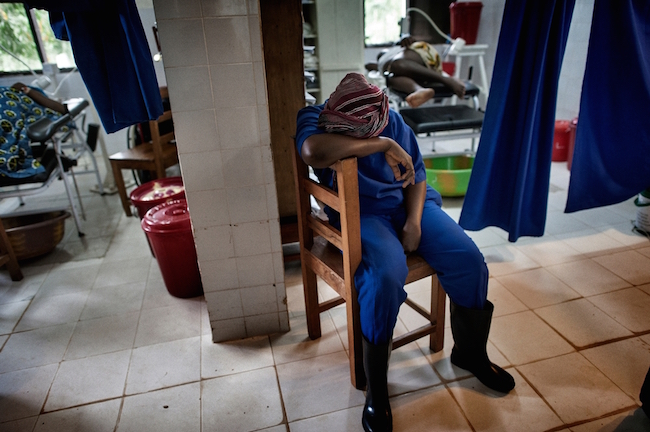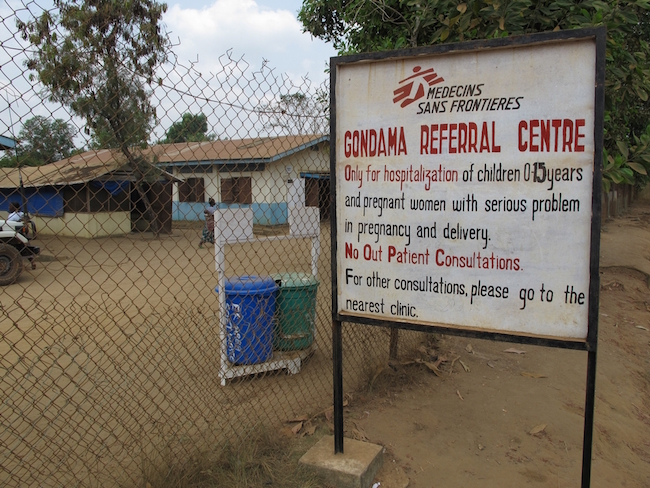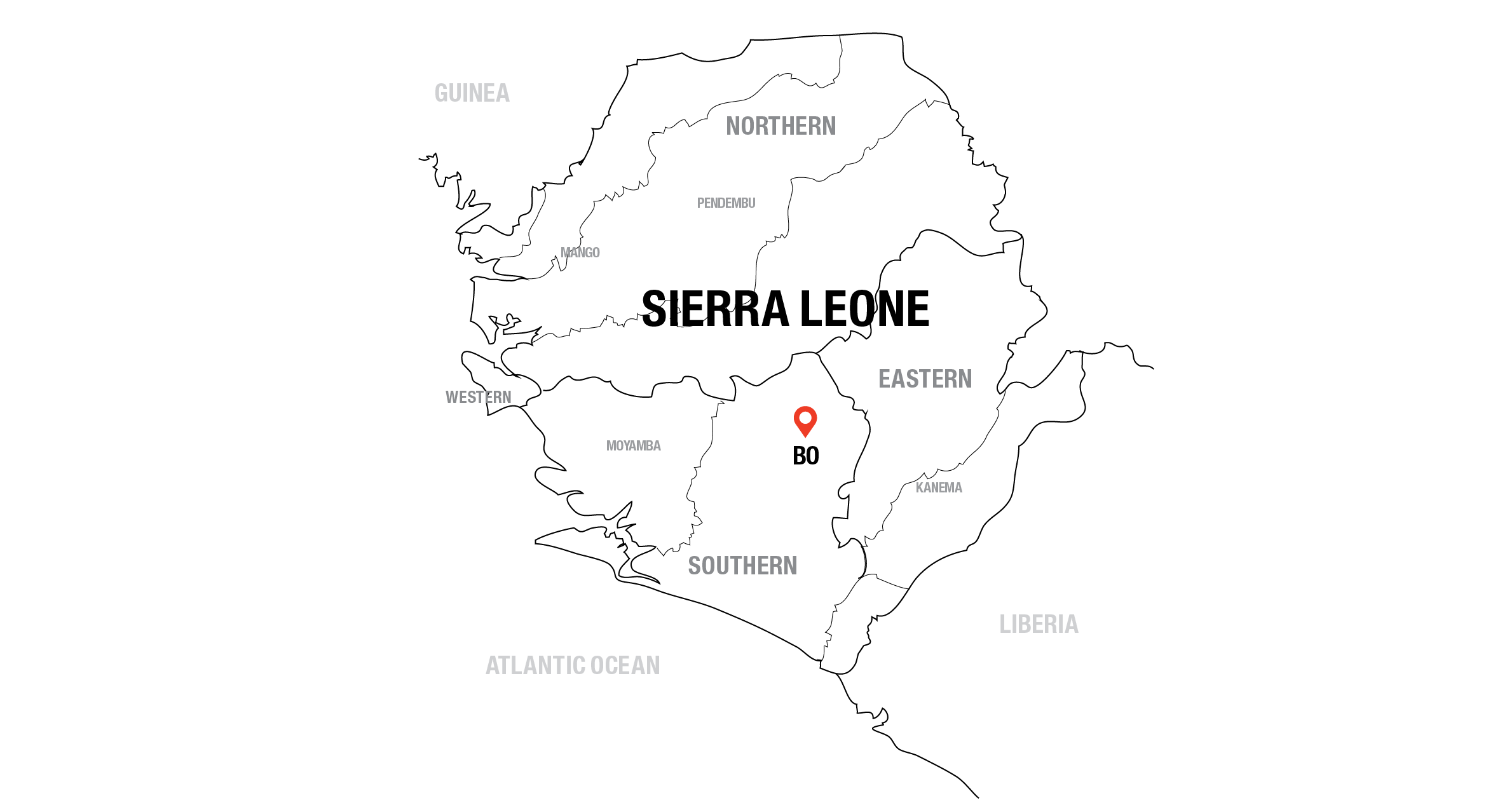

What It Takes To Make A Difference:
An OBGYN’s Journal in Sierra Leone
By Betty R. Raney, MD, OBGYN
My name is Betty Raney and I live in Charleston, South Carolina. I have worked as an obstetrician and gynecologist in the U.S. for 25 years, 22 of them in my home town of Indianapolis. My first assignment with Doctors Without Borders/Médecins Sans Frontières (MSF) was in Bo, Sierra Leone, for six months in 2012.
I know our team made a difference in Bo. By running a 24-hour, high-risk obstetric unit, and having a referral system to transport emergency patients from outlying villages and towns by ambulance to our facility—the Gondama Referral Center—MSF estimates that the maternal death rate in Bo district decreased by 61 percent.
The maternal deaths were the hardest part of my mission; they were something I never thought I would experience in my career. With the first death, I was devastated for days. In the U.S. we can largely save young healthy women because we have every medical device, medication, and specialist at our fingertips. That was not the case in Sierra Leone. Whenever I was struggling with this, I talked to colleagues, and sometimes called home. Gradually, I accepted that I could not save everybody and it was not my fault. My efforts and concentration needed to go towards those I could save.
The following are excerpts from the journal I kept during my time in Bo.
June 1: Arrival
I’m writing in the car. Made it here late last night after an eight-hour flight to Brussels, then a six-hour flight to Lungi Airport, Sierra Leone. About an hour later I was on a boat to Freetown.
The MSF driver picked me up when I got off the boat and we drove to the MSF house. Even though it was dark, I was smacked in the face by the profound poverty. Rows and rows of homes that were nothing more than lean-tos made of sticks, tin, cloth—no bigger than one bedroom in my home and these were the homes of entire families.
I slept five hours and am now on a six-hour car trip to Bo. I skipped the briefings in Freetown today because they are so busy they need me in Bo right now.
Whereas Freetown was dirty and noisy, the countryside is lush, tropical. It’s amazing what the women can balance on their heads. Their clothing is so bright and beautiful. I don’t know how it is so because none of the shanties have electricity, water, or even windows or doors.
I’m tired but I’m going to work.
June 2 My First Day
My OBGYN partner was evacuated yesterday due to possible exposure to a patient suspected of having Lassa feveri—the Lassa virus is endemic here.
One of my first patients had had a botched illegal abortion that extruded to the abdominal cavity. She was septic and very ill, only 16 years old. Note: She later died of infection.
There is lots of death here. According to the handover reports from other doctors, there have been one to four maternal deaths per month at the Gondama Referral Center. UNICEF reports that 11.7 percent of infants born alive in Sierra Leone died in 2012 and more than 18 percent of children under five died.ii
iLassa fever is an acute viral hemorrhagic illness caused by Lassa virus.
iiUNICEF, At A Glance: Sierra Leone, 2012, http://www.unicef.org/infobycountry/sierraleone_841.html
June 3 How MSF Got Here
I just finished my rounds. I did a dilation and curettage (D&C)iii for an incomplete spontaneous abortion or miscarriage and heavy bleeding. Then a Caesarean-section for a woman who had been in labor for three days with a baby too large in relation to her pelvis to come out vaginally—she had a placental abruptioniv and was bleeding.
Baby and mom are now doing well.
I learned that this hospital dates back to the war in Sierra Leone in the mid-nineties. MSF treated victims of the civil war, then refugees fleeing Liberia’s civil war. It became Gondama Referral Center in 2007. Now it is here for the entire community and beyond as a measure to reduce maternal and child mortality.
iiiD&C is a surgery done when a woman is having heavy vaginal bleeding from a miscarriage or another cause. It involves cleaning out the uterine cavity, which is usually successful in stopping the bleeding.
June 4 Blood
After 24 hours on call, I am still wide awake due to the Lariam (mefloquine hydrochloride) I’ve been taking to prevent malaria. My mind has been spinning with the day’s activities—four C-sections for four live babies, one placental abruption, one hemorrhage/placenta previa,v one transverse lie,vi one obstructed labor, and one D&C.
Any surgical patient here must have relatives to donate blood or she will not get blood during or after surgery if she needs it. If the lab has blood from another patient’s donor, they won’t let you have it because blood is so very scarce. If we take another patient’s donated blood, she won’t have blood when she may need it, which is unfair to her. In spite of this, it causes great anxiety in a doctor to know you have a patient who will die if she does not receive blood, and you see the unit you need sitting in front of you in the lab refrigerator.
Note: I gradually learned how to get the lab guys to release blood to me in an emergency. I would promise to find other donors and they eventually learned that I was true to my word. It was a daily battle to find donors. We really needed a person to do just that, find donors, every day, all day long. Sometimes we recruited our mental health counselors for a couple of hours to do this for us.
We do not transfuse the blood if it is positive for HIV, hepatitis, or syphilis. We do transfuse malaria-positive blood because at least 5 percent of all blood is malaria-positive. Then if the patient develops malaria, we treat her. It is just so difficult to get donated blood and malaria is so prevalent and easily treated.
ivWhen the placenta peels away from the inner wall of the uterus before delivery, it can deprive the baby of oxygen and nutrients and cause heavy bleeding in the mother.
vWhen a baby’s placenta partially or totally covers the mother’s cervix — the opening between the uterus and the vagina. Placenta previa can cause severe bleeding before or during delivery.
viWhen a baby is positioned horizontally across the uterus, rather than vertically.
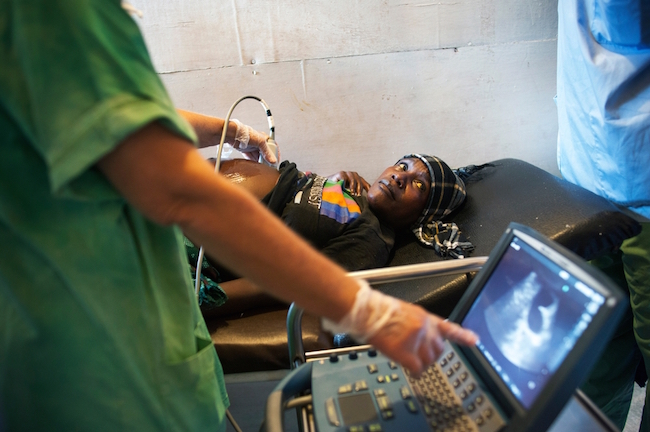
Dr. Raney performs a sonogram for a pregnant woman at the Gondama Referral Center in Bo. Photo by Lynsey Addario
I had a busy day, two interesting patients:
Someone had stuck an object into her to get her to abort, but the object never went into her cervix or uterus.A 21-year-old who had a botched illegal abortion more than a week ago came in for pain. Her uterus was the size of a 4.5-month pregnancy, full of placental and fetal tissue. Someone had stuck an object into her to get her to abort, but the object never went into her cervix or uterus. Instead, it went from the vagina, through the vaginal wall, directly into the abdominal cavity. The damage was extensive. I tried to save the uterus but to no avail. I initially did a wedge resection, but then had to do a hysterectomy and removal of the right ovary.
A 14-year-old who delivered eight days ago had obstructed labor and her baby died. She now has a obstetric fistula—an opening between the vagina and the bladder—caused by the baby’s head pressing hard against the pelvic bone for so long. She has also been having fevers and diarrhea. On rounds her respiratory rate was 60 (normal is around 12) and blood pressure 60/40. Obviously, she is septic.7 Is it endometritis or typhoid?8
Note: It turned out to be typhoid. I started her on an antibiotic regimen. With typhoid, people get multiple tiny bowel perforations. We have no general surgeon on staff to take care of this. She may die tonight.
7Sepsis is an infection that has gone into the blood stream. Many people die from septic shock. The blood pressure becomes so low that blood does not reach all the critical organs, including the brain.
8Endometritis is inflammation or irritation of the lining of the uterus; typhoid is a life-threatening bacterial disease.
June 7 Foot Drop
The 14-year-old is no better, a little worse in terms of her fever and massive diarrhea. She does not have an acute abdomen. There is no cholera in the area.
I am seeing a lot of foot drop in these young women with obstructed labor. They are not able to pick up a foot as they walk, due to nerve damage. It happens when the baby is stuck low in the pelvis for so long that it presses on the nerves that go to the feet and the nerve dies off, permanently. They just live with it.
Premature babies here have only a 20 percent chance of surviving the first 24 hours.June 9 Unexpected Triplets
The woman with typhoid is hanging in there.
Today, I delivered triplets vaginally. I was unaware of the third baby until I was trying to find the placenta and felt his head. The first triplet was a breech—head was entrapped for around three minutes. The baby didn’t make it. The second and third babies looked good but were much smaller. As healthy as they look, premature babies here have only a 20 percent chance of surviving the first 24 hours. If they make it home, they have a 30 percent risk of dying before age five.
I hate delivering premature breeches—in the U.S., we always deliver these via C-section. Here, we do our best to avoid C-sections, because if a woman who has had a C-section gets pregnant again before her scar has healed and is unable to access emergency obstetric care, she is at great risk of dying.
Another sobering fact I’ve just learned: pediatricians here told me that we have HIV-positive moms breastfeed because babies’ survival rates are higher if they get breast milk and HIV than if they don’t nurse. However, we know that if the mother is on an effective antiretroviral regimen—which many are thanks to a free treatment program run by the local government hospital—the HIV will become almost undetectable in her blood, so therefore the chance of transmitting it to her child is very small.
The infant survival rates are dismal here and babies have a much higher chance of surviving if they get their mother’s milk. Moms have been exposed to many infections throughout their lifetimes, so they have immunoglobulins in their blood and in their breast milk, which go to the baby and prevent infections. For example, many babies die from malaria; most moms have had malaria off and on their whole lives and their breast milk is so rich in these antibodies against malaria that babies are much less likely to catch malaria if they breastfeed.
Also, if they don’t nurse, these women have no way to buy formula, and if they give a newborn cow’s milk, tea, or water, the baby doesn’t grow, becomes undernourished, is more susceptible to disease, and dies.
If a child does develop HIV, we can put him or her on treatment.
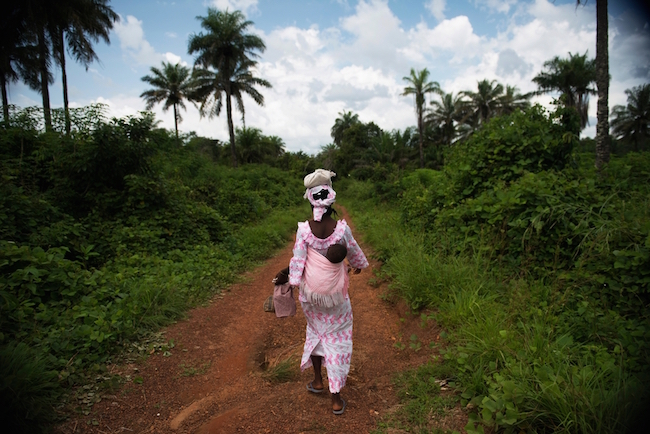
A mother walks back to her village after coming to the GRC to get her baby vaccinated. Photo by Lynsey Addario
Every day I see eclampsia—untreated high blood pressure that develops into seizures in pregnant women; ruptured ectopics—embryos that are implanted outside the uterus; obstructed labor; and retained placental and fetal tissue. A 19-year-old came in today who had taken large doses of antibiotics to abort. She had an incomplete abortion, needed D&C.
June 16 Illegal Abortions
The day before yesterday, two women came in, each with her baby’s foot presenting. The first one I was able to deliver vaginally. The second one I delivered by C-section and it was surprise twins.
I see patients daily with retained products from illegal abortions. A 14-year-old who was impregnated by her teacher and had an illegal abortion came in today. She had had a stick placed in her cervix for two days. She came in terribly infected—needed antibiotics, D&C.
I admitted a woman, four weeks post-partum with twins. She was vomiting and had pain in her upper abdomen. She had a very large liver on exam and the ultrasound showed large portal and splenic veins and a large colon. She kept vomiting and her hemoglobin kept dropping. I transfused her. She tested positive for schistosoma, the parasitic worms that cause schistosomiasis. These worms are picked up in fresh water through skin contact and she might have gotten them in the Sewa River, where people bathe and wash clothes. I sent her to Freetown for an upper endoscopy.
A normal hemoglobin here is 6 or 7. We see many women with hemoglobin of even 2 to 4 so they need immediate blood transfusions. It is a constant battle to round up blood donors from the family.
I was confined to quarters for three days due to a 104°F (40°C) fever. Haven’t been that sick since I was 12 years old with dengue fever (I grew up in Thailand). This is the first time I have ever missed work due to illness, except for a bike wreck. I’m homesick for family because I have had too much time on my hands.
June 19
Better now and back to work.
This truly is a difficult place for those who live here. When you look around, it is beautiful, but it doesn’t change what it is for people. Their lives are unimaginably difficult, every second of the day—never enough food, frequent illnesses that go untreated, sleeping in the dirt in an open shack at night.
June 20 Maternity Waiting Houses
Women here are most often pregnant 9 to 11 times during their lives and I have seen women have as many as 13 to 17 pregnancies. In spite of this they may have only two to six living children. There is a very high rate of stillbirth and infant mortality. My assumption is that the high rate of stillbirths is due to no prenatal care, poor nutrition, rampant hypertension in women, chronic severe anemia, malaria, and poor dental condition, which causes infections.
Most women give birth at home with a traditional birth attendant. Once a problem occurs, the pregnant woman still has miles to walk on foot from her village to our center. If she can’t walk, family members may bring her on a motorbike—I saw it twice this morning. One man sits on the back of the motorbike and cradles the unconscious woman in his arms and she is wedged between him and the driver. It’s amazing what people do with limited resources. But often they are too late—for both mother and child.
When a woman starts labor, or even before labor, she can go to the waiting house with a caretaker and stay there.A major part of MSF’s mission here is to reduce maternal and newborn mortality. We have constructed maternity waiting houses next to five outlying clinics in the area. When a woman starts labor, or even before labor, she can go to the waiting house with a caretaker and stay there. Patients and caretakers are fed, given beds, and provided with medical care.
The women then deliver in the clinics, which are staffed with midwives, and if there is a complication MSF has an ambulance at each clinic to transport the patient here to the Center for intervention. This saves thousands of lives, but the effort needs to be larger. More than 85 percent of women still deliver at home.
June 22 The Dangers of a C-Section and Genital Mutilation
Something contradictory to all I have ever done in the U.S.: we will sometimes sacrifice the life of the baby here in order to save the mother a life-threatening complication or a C-section. For example, we will deliver breech babies vaginally, when at home we would always do a C-section because of the risk of trauma to the baby. Here, we have to think about the fact that many women are likely to become pregnant again before the C-section scar heals, and without a guarantee of emergency obstetric care for her next pregnancy, her life will be in danger because we gave her that C-section. If a mother dies and leaves other children behind, those children have a much lower chance of surviving. In the U.S. we do not usually have to make these kinds of decisions.
Last night I delivered breech twins to a woman in her first pregnancy. Both deliveries were fairly traumatic for the babies. I had not delivered a vaginal breech since I was a resident over 25 years ago.
The first baby will do OK; I don’t know about the second one, who was the larger. He had one hyper-extended arm over his head, which made him quite difficult to extract. When I left he was starting to breathe on his own, but only after 15 minutes of resuscitation with a mask and bag.
Today I sent home the 14-year-old patient who had undergone a dangerous abortion after being impregnated by her teacher. I treated her infection and gave her a contraceptive implant. She will most likely be infertile because her infection was severe enough to cause scarring and obstruction of her fallopian tubes.
About 95 percent of women here have undergone female genital mutilation. In the form done here they cut off the clitoris and the labia minora. They usually do not sew the introitus (vaginal opening) closed, although I have had one patient with that procedure done. Women can suffer a lot of pain due to the scarring this causes. The procedure is performed by a person with no medical training in the community who may use the same blade on many girls. In Sierra Leone it happens around age 12, in other countries, like Sudan, it can happen earlier.
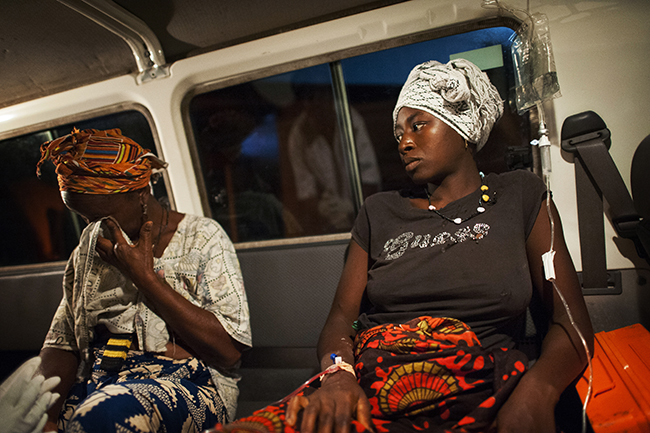
A 22-year-old woman, right, is brought by ambulance to MSF’s Gondama Referral Center from a government clinic after suffering a miscarriage. Her mother, left, cries as she accompanies her. Photo by Lynsey Addario/VII
I had the first maternal death of my 25-year career this week.June 28 My First Maternal Death
I had the first maternal death of my 25-year career this week. This was a woman who came in with a dead baby due to a massive placental abruption. She had suffered a large amount of bleeding because after the placenta comes off the uterus needs to contract to stop the bleeding, but it cannot contract enough if the baby and placenta are still inside.
She was unstable from the second she entered our door. Her hemoglobin was 4.5 (a normal hemoglobin here is 6 or 7). Once she delivered, she was in disseminated intravascular coagulation (DIC), meaning all the clotting factors in the blood were used up. I worried about an undiagnosed uterine rupture as the uterus wasn’t firming up. We kept losing blood pressure on her. She was transfused. I needed to do a hysterectomy.
When we finally got a blood pressure of 60/40 I did the hysterectomy. She had a massively atonic uterus—it would not contract anymore because it had been contracting so much to try to stop the bleeding, it gave out. She also had a large blood clot next to the uterus, caused by the abruption.
I did suprecervical hysterectomy (leaving the cervix in place) and filled her abdomen with packs. She got a total of five units of blood—no one here ever has the luxury of five units of blood. She lived about three hours post-op, but we had no way to reverse her DIC. Her bed was full of watery candy-colored blood when she died.
In talking to the other OBGYNs, I learned they also had never had a maternal death in their extensive careers until they worked in Sierra Leone. We have about one per week, sometimes up to seven per month. That is life as a woman in this part of Africa. This patient had six children at home. Her name was Betty. She was 36 years old. That day, every baby that came into my labor and delivery was dead … every single one.
July 2 14-Year-Olds Aren’t Supposed to Have Babies
Fatmata is the patient with typhoid I wrote about last month. She is a small girl, around 14 years old. She came to the Gondoma Referral Center with a dead baby and a ruptured uterus. She had surgery, then for two weeks was very sick with typhoid and almost died.
As a result of her obstructed labor she now has both a vesico-vaginal fistula—an opening between the vagina and the bladder—and a urethral-vaginal fistula—an opening between the vagina and the urethra. She walks around all day leaking urine. They do not have pads in the hospital, so she just leaks. I buy her bags of pads from the mini-mart but they go fast; she needs cases of them.
Not only that, she has severe pain in her right foot and right foot drop from the baby having compressed the nerves against her pelvic brim. Yesterday she was crying and moaning the pain was so severe. I started her on steroids and an analgesic and she is better today and walking a little easier. All of this—the fistula with urine leaking and the foot drop, which is permanent—is because 14-year-olds aren’t supposed to have babies.
It is a cruel thing for nature to allow fertility before it allows the body to be able to carry a baby without destroying it.Fatmata will soon be transferred to the West Africa Fistula Foundation extension at Bo Government Hospital. There is a surgeon from Texas who comes once a year to repair women’s fistulas. I don’t know if Fatmata’s can be repaired because it involves a large portion of her urethra. It is a cruel thing for nature to allow fertility before it allows the body to be able to carry a baby without destroying it.
July 7 Communication Challenges
Yesterday was busy. It was a day full of women seizing, and women walking into the hospital in obstructed labor with a baby’s arm presenting.
The patient I am most worried about arrived one month after delivery, vomiting worms. I had done a breech vaginal delivery on her. We treated her for worms and she has progressively gotten worse. She has some type of encephalopathy and is not coherent, does not talk, does not eat, has been constipated for almost a week now. Is it HIV encephalopathy9 caused by longstanding AIDS? Some worms go to the brain and lungs. We have no testing available for brain disease. Note: She eventually died.
The hardest thing about working here is not being able to talk directly to my patients.The hardest thing about working here is not being able to talk directly to my patients—90 to 95 percent of the time a diagnosis is made by taking a history from the patient, and we use nurses and aides as our translators. We get only a small part of the story and often patients lie to you, especially in the case of illegal abortions. It is so difficult to not be able to ask them questions directly or offer any comforting or reassuring words.
9 Encephalopathy is a disease of the brain that alters brain function or structure.
July 13 Blood Again
Chronic problem: the only thing not provided to patients by MSF is blood. Patients must bring blood donors (usually relatives or friends) with them.
One woman brought three donors, none of whom was helpful: the 20-year-old husband tested positive for HIV; her mom tested positive for hepatitis C; her aunt had blood type AB+, which is the only type we have too much of and gets thrown away. I practically had to sign my life away to get her a unit of blood from the blood bank—I basically stole it from another patient with the promise I would find more donors to donate. Always a problem, a daily struggle.
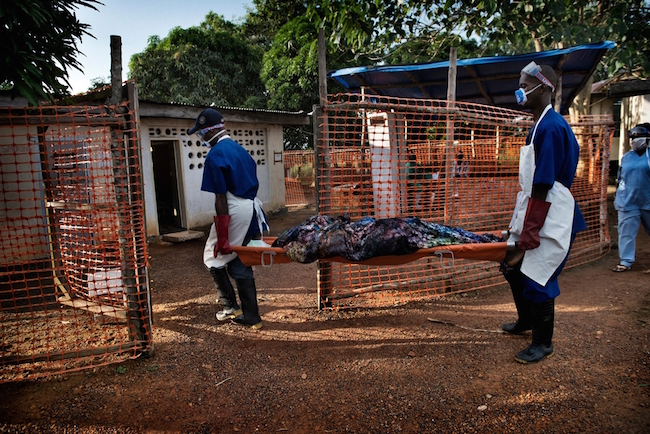
Hospital staff carry a young woman who lies in a coma after suffering from post-partum hemorrhage while delivering her baby at a government clinic. Her in-laws brought her to GRC for emergency care, but she did not survive. Photo by Lynsey Addario
She would have arrived two hours earlier, but the ambulance at the clinic in Kenema had no fuel.July 21 Against All Odds
One of the biggest problems here is late presentation to the hospital. Yesterday, a woman arrived in septic shock and DIC10. She would have arrived two hours earlier, but the ambulance at the clinic in Kenema had no fuel. If she had arrived a few minutes later she would have died.
This woman had been having pain for about a month. After performing a laparotomy11 on her I determined that she had had a ruptured pregnancy in her fallopian tube, which occurred about a month ago. The pregnancy was expelled from the tube and the placenta then implanted on the right pelvic sidewall. It was approximately a 10-week pregnancy growing in her pelvis. Most women do not survive this type of thing, but she is doing well.
We are down one person so I am on call every other day for a while—28 hours on, 20 hours off until a replacement arrives in a week or so. Only the other OBGYN and I seem to think this schedule is a problem.
Just finished in the operating room. A woman came in at 6 a.m. today, Kadijatu. She is 32 years old and had a spontaneous abortion. She stated that her placenta delivered in the clinic but the baby did not. She denied bleeding, but it is not possible to have a placental abruption with no bleeding.
I took an ultrasound scan and saw that the uterus had ruptured and pushed the baby out into the abdomen. There was a tiny, empty uterus in her right lower quadrant with the baby on the outside, right next to it. In the U.S., women die from this if they do not make it to a hospital.
I secured blood for her and took her to the OR. She had massive uterine rupture and I fished the baby out of her intestines. The uterus was blown out beyond repair so I had to remove it.
Right before I went back on that case, a woman walked in with her baby’s head presenting. It was a dead fetus and its head had been out for over 12 hours. The baby’s shoulder was stuck; I relieved it and delivered the baby. It took me about 90 seconds. The patient was so grateful. The baby looked perfect and full term, but was dead.
I also did a C-section on a woman who came in with her baby’s arm presenting. I’ve had three such presentations all in the same day here. In the U.S., I have seen it once in 25 years.
10Disseminated intravascular coagulation (DIC), in which excessive blood clotting leads to the inability of the body to clot the blood at all.
11An incision through the abdominal wall made to gain access to the abdominal cavity.
July 25 A Miracle
There are small glimmers of hope here at times. The woman in septic shock who was stuck in Kenema for two hours due to a lack of fuel is alive and I think she will make it. This is very unusual in her circumstances and our chief health officer calls it “a truly miraculous case.” These are the exact words he used when he and I went to the blood bank yesterday morning to beg for one more unit of blood for her. Her hemoglobin is still 4.6, which will not allow her to heal.
July 27 When the Pharmacy Is Closed
Except for Gondoma Referral Center, the hospitals in Sierra Leone do not have drugs or supplies such as bandages. If a patient goes to a hospital for a problem, the family is given a list of meds and supplies to go out and buy at the pharmacy for the patient. The pharmacies close at 9 p.m. Many patients die at night because there is no access to drugs they may need immediately.
Foday is one of our anesthetists. His 36-year-old brother died of a hypertensive crisis last week because he arrived at another hospital at night, and there were no drugs.
The other issue is payment. If the patient doesn’t have the cash up front to pay for the surgery or treatment, the staff will watch the patient die of a ruptured uterus or ruptured appendix or whatever other ailment they have.
August 5 Eclampsia
Two days ago, as I was finishing my shift at 7 a.m., the ambulance rolled in with a 17-year-old pregnant girl in a coma. At 10 a.m. the previous day she had had a seizure at home in her village. Her family placed her on a cloth stretcher and walked her to the nearest health center, which was a 20-hour walk. She was then put in an ambulance for a four-and-a-half hour drive over a rough road, where her mother delivered the baby during transit.
When she arrived she had so much facial and neck swelling that her face and neck just blended in with her shoulders. She was stridorous, producing a high-pitched sound due to swelling of her airway. Her blood pressure was high and she had protein in her urine, all the symptoms of severe, life-threatening eclampsia. We put a plastic syringe between her teeth so she would quit biting her tongue and started her on phenobarb, the only anti-epileptic med we have.
In the U.S. our hospital beds move into Trendelenburg with the touch of a button. At our center, we put cement blocks under the bed frame at the bottom.August 10 Malaria
She is improving each day. The baby is fine. All in a rough day for a 17-year-old.
Yesterday morning I got to work, started rounds, and noticed that someone in the ward was on oxygen. This is not normal. Within 30 minutes they called me to see her because they could not get her blood pressure. I hung plasmanate, an IV fluid that is a blood plasma expander, and checked hemoglobin and blood sugar. Her hemoglobin was stable at 7.3 but her blood sugar was undetectable.
Her para-check test for malaria was positive and now she was comatose. I gave her two vials of D50, a sugar injection, and brought her sugar up to 60. I started IV artesenate, gave her fluids, and put her in Trendelenburg—tilting her bed so her head was much lower than her feet. This is done when blood pressure is very low and we want to perfuse the brain and prevent brain damage. In the U.S. our hospital beds move into Trendelenburg with the touch of a button. At our center, we put cement blocks under the bed frame at the bottom.
I examined her from head to toe. We had put her on triple IV antibiotic therapy for a fever. She had arrived ten hours prior, with an undelivered four-and-a-half-month-old dead fetus. Her temperature had been 101°F (38.3°C) but now she was ice cold. We put warming blankets on her and then she died. She was 43 years old, her name was Isatah and she had six children. She died of advanced cerebral malaria.
Pregnancy reduces a woman’s immunity to malaria. She becomes more susceptible to infection and this increases the risk of illness, severe anemia, and death. For an unborn child, maternal malaria increases the risk of spontaneous abortion, stillbirth, premature delivery and low birth weight—a leading cause of child mortality.
It was a terrible night. I feel like a boat that leaves nothing but death in its wake.August 19 Why Am I Here?
It was a terrible night. I feel like a boat that leaves nothing but death in its wake. I delivered 32-week twins by C-section three days ago. They were both transverse lie, lying sideways across the mother’s abdomen. The second one died today, the first one yesterday.
A 19-year-old girl came in with cephalopelvic disproportion (CPD)—she had pushed so long and so hard at home that the baby’s head had molded to try to fit through the birth canal. The baby was too far down at the time of the C-section, so I pushed it up before starting and the nurse pushed it up during the operation, but my hand still would not fit down past her pubic bone. With a head-down C-section we usually scoop the baby’s head to pull it through the incision, but in this case it was not possible. So I extended the uterine incision and had to find the feet to pull the baby out as only the head and feet can fit through a small incision. This was the first time I had delivered a head-down baby feet first. The baby died, two hours after delivery.
August 24 Resilience
About 12 days ago, the 17-year-old who arrived in a coma started to walk with a walker and her seizures were lessening, but she had urinary retention and was unable to go to the bathroom. Her walking continued to improve every day and she had no foot drop. Today she went home on meds for chronic hypertension only. This woman undoubtedly had a stroke, followed by an amazing recovery. The healing properties of the body plus the resilience of women here amaze me.
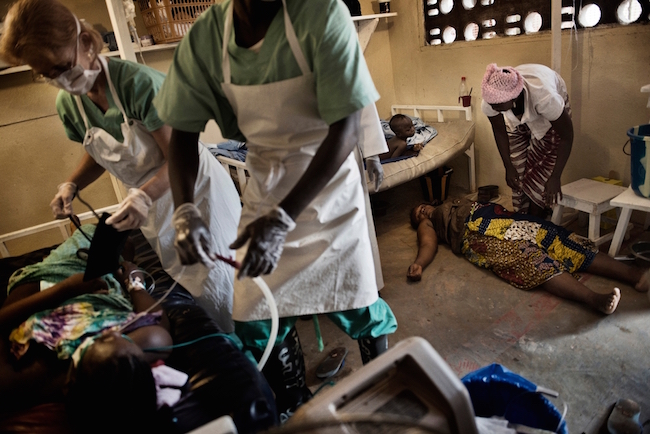
Dr. Raney and another medical staff member try to save a 20-year-old woman who went into a coma after suffering from post-partum hemorrhage at a government clinic. The patients was driven two hours to the Gondama Referral Center to receive emergency care. Photo by Lynsey Addario/VII
Last night I saw an eight-year-old sexual assault victim.August 27 A Child Victim of Rape
Last night I saw an eight-year-old sexual assault victim. Most of the sexual assaults here are on female children under the age of ten, all the way down to one-year-olds. This child was held by a man at knifepoint. He perforated through her vagina into her abdominal cavity. Her perineum was torn wide open and her rectal opening was damaged. She was having heavy vaginal bleeding. I have treated her for all sexually transmitted diseases and she is being prophylaxed for HIV. She has received tetanus and hep B vaccines. I will be able to repair her injuries.
September 12 Another Child Victim of Rape
The eight-year-old who was raped went home today. She is running, laughing, and singing and seems to be a totally different child.
I spoke to my partner who is on call tonight. She is tending to a rape victim who is one year, eight months old. She was raped by her father and is bleeding.
Lots of good things happen at our hospital, too. Lots of lives saved. Still lots to be done.
The labor room was full and stayed full for the entire 24 hours.
October 12 One Crisis After Another
Rough 24 hours on call. I started rounds at 8:15 a.m. and had 25 patients to see. The labor room was full and stayed full for the entire 24 hours.
My first patient was a woman with two prior C-sections who needed a third C-section. It took two hours as the scar tissue from the previous operations was so bad. I had to pull the baby out of the fundus—the upper end of the uterus—instead of the lower segment. The anatomy was distorted and the bladder was very swollen after a long labor.
I then ran out to do a vacuum delivery on a woman who was screaming and would not push.
Then, I had another C-section on a woman with obstructed labor whose vulva was swollen to the size of a large grapefruit.
And then I came out to stitch up a woman bleeding from an extensive vaginal laceration, which occurred at a clinic during delivery. She had a hematoma—a collection of blood outside of the blood vessels—that was the largest I have ever seen, extending halfway up her buttock. I iced her down after doing the repair.
Now there was a third C-section to do on a woman whose cervix was so swollen that there was no way a baby could come through. Her C-section was as difficult as the first one of the day and this was the second time that day I took a baby out of the fundus of the uterus. The incision was huge—putting the incision up so high in the actively contracting part of the uterus puts her at high risk of uterine rupture during her next pregnancy. She would not let me tie her tubes.
After I finished rounds I delivered a VBAC—a vaginal birth for a woman who had previously had a Caesarean. Her previous baby had died and this one was dead by the time she arrived at the hospital.
Now it is night and I am doing a secondary wound closure that I had planned for 10 this morning. The entire 24-hour shift continued this way and I finally emptied the labor room at 7:30 the next morning, just in time to turn it over to my partner and to decide that I am in no hurry to come back!
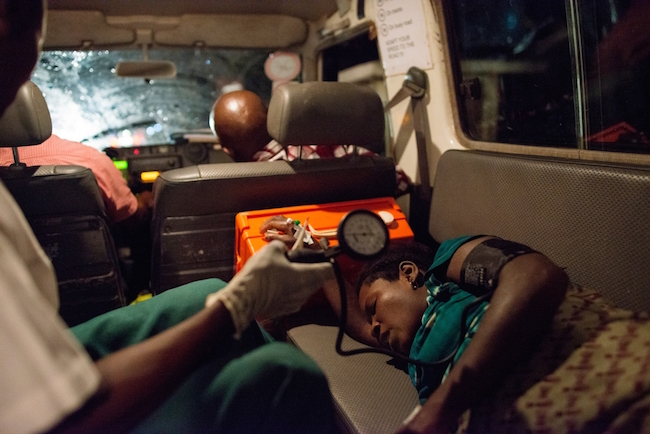
A pregnant woman is transported in an MSF ambulance from a government health clinic to the GRC. She is not yet in labor, but is at high risk for needing a C-section when it is time to deliver. She will stay in an MSF maternal waiting house, where expectant mothers can live beside the GRC, under the observation of medical staff, until delivery. Photo by Lynsey Addario/VII
My 24-hour shift from the 19th to the 20th was so busy, but so interesting. I came on duty at 8 a.m. and had a patient in the labor room, so I went there first.
She was a 19-year-old complaining of an incomplete miscarriage. Her temperature was 104°F (40°C) and her lower abdomen was tender. I put the ultrasound on her and she had what appeared to be an incomplete abortion and a 10 cm abscess in her pelvis. When I asked what kind of instruments had been put up inside her she admitted to going for an illegal abortion.
I had to remove both fallopian tubes and this 19-year-old will never have children. Invitro fertilization does not exist in Sierra Leone.I started rounds while the nurses began her IV antibiotics and readied her for surgery. I finished rounds and opened her up. She had a gallon of pus in her pelvis and both tubes were swollen to ten times normal size and filled with pus. I did a D&C before opening her and emptied her uterus. I had to remove both fallopian tubes and this 19-year-old will never have children. Invitro fertilization does not exist in Sierra Leone. She will be barren and unable to keep a husband, which, in this country, is culturally one of the worst things that can happen to a woman.
After that surgery a new patient came in who was pregnant and had gone two months without a period. I scanned her because she was too tender to examine. She had an acute abdomen with rebound tenderness—pain upon removal of pressure. Her pelvis was full of blood. I took her to surgery assuming she had a ruptured ectopic pregnancy but found that she had a twin ectopic pregnancy—one in each fallopian tube. There is a high rate of twins here.
One tube was ruptured and destroyed so I removed it. The other tube was not as distended so I opened the fallopian tube, removed the pregnancy and left the tube intact. She had no children and was only 20. She had old chlamydial type scar tissue in her pelvis. She is at high risk of future ectopic pregnancies but she at least has a chance at having children.
After this surgery I went out to the labor room to see a new patient. She was a 20-year-old brought in with a retained second twin. The grandmother was carrying around the first twin who looked very small. The first baby had been born five to six hours earlier in an outlying health center.
I scanned the patient and the second baby was double footling breech—both feet were presenting—and measured 26 weeks, with a good heart beat. The placenta looked very low. She was 5 cm dilated and 80 percent of the presenting part was placenta. If I pushed my fingers beyond the placenta I could feel two tiny little feet. I started Pitocin to increase contractions and hopefully get her delivered quickly before she bled to death from the placenta presenting first. I did not want to C-section her for a 26-week baby who was not going to survive.
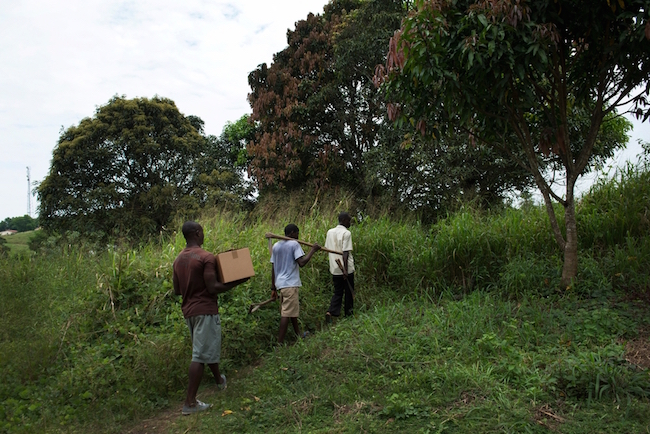
Relatives and villagers carry the body of an infant who died the day after he was born at the GRC. The mother had had an emergency C-section. Photo by Lynsey Addario/VII
She was still bleeding heavily. I scanned her and there was no retained placenta. There were no lacerations. Her hemoglobin was now 1.7 and she was fading in and out of consciousness. We got plasmanate, a volume expander, to try to raise the blood pressure and the amount of blood and squeezed it in as fast as it would run. We had the usual anxiety/trauma of no blood in the blood bank and needing to round up donors.
I thought she would die because it took a while for us to find blood, but she didn’t.I put our only obstetrical balloon (used for the temporary control and reduction of postpartum hemorrhage) in her uterus and inflated it and the bleeding stopped. I thought she would die because it took a while for us to find blood, but she didn’t.
Meanwhile the woman with the second retained twin delivered without event. The grandmother walked back in the labor room with the swaddled first twin and I noticed it was dead—I’m sure of severe prematurity. The second twin weighed only 2.6 pounds and went to the neonatal unit, but he will die also because there are no ventilators in the neonatal unit to help him breathe.
The next woman I saw had a retained placenta. She had delivered at home and bled heavily. Her hemoglobin was 3.0. There truly was no blood for her. She was bleeding so much I took her back to OR. She seized and passed out as we placed her on the stretcher to take her back. I told the anesthesiologist I figured her hemoglobin was really about 2.0 but she was going to die of hemorrhage in the ward and I had no option other than at least trying to remove the placenta.
People with hemoglobin of 2.0 don’t tolerate anesthesia very well. We were trying to borrow blood from the local hospital but they had no B-. Just as I started surgery, the head nurse came running in and said they had one donor in the lab who was B-. Within 15 minutes she was being transfused. It was a difficult manual removal of the placenta but I got it out. Over the course of the day I found two more units of blood for her.
I took five minutes to eat since it was now 8 p.m., then returned to the labor ward to see a new patient.
She had been transported in by our ambulance with her baby hanging out up to the chest. The head, arms and chest were out and the rest of the baby wouldn’t deliver. Prior to transport, the baby had a heart rate but upon arrival at our hospital the baby was dead. The midwife agreed to attempt this delivery while I checked quickly on the woman with the obstetrical balloon in.
When I walked back in, she had the baby out. It was a perfect little girl around 5 pounds with an 8 pound, 10 cm solid mass extending off her sacral/lower buttock area. I’m guessing this was a large sacrococcygeal teratoma, a kind of tumor located at the base of the tailbone.
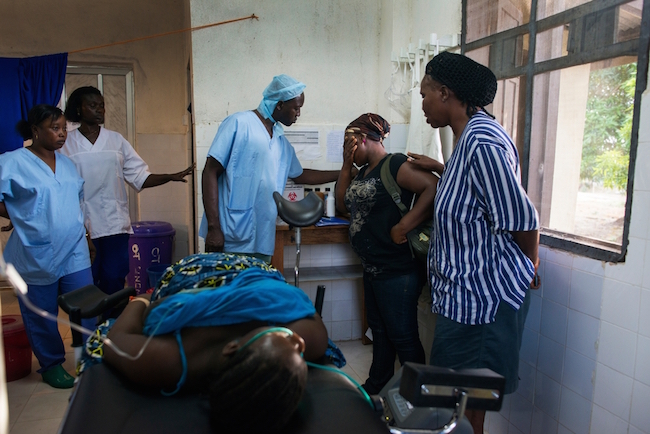
A third year medical student, lies in a coma. She was suffering from post-partum hemorrhage while she was delivering her baby at a government clinic outside of Freetown. She was sent to the MSF hospital for emergency care. Photo by Lynsey Addario
At 1 a.m. today, a 20-year-old woman arrived in a coma. She had delivered her baby in a clinic in Moyamba three days ago. She then walked back to her village. The day after delivery, she had a headache and went to sleep and she never woke up. She has shown slight improvement in the seven hours she has been with us.
She now has some spontaneous movement of her arms, head, and eyelids. She responds to deep pain with withdrawal of her hands and feet. She has no facial asymmetry and her pupils are equally reactive to light. Her hemoglobin was 5.0 and her blood sugar was 40. She is febrile and does not have malaria. I transfused her and gave her D50, an intravenous dextrose solution. Today we will feed her via tube with vitamin-rich therapeutic food. She will hopefully continue to improve. Her name is Christiana.
October 30
Christiana is still alive but totally unaware of her surroundings. She opens her eyes a lot but if you move your hand quickly towards her face, she doesn’t even blink—as though she doesn’t see at all. Her blood pressure has risen significantly, which makes it look more as if she has had a major stroke from preeclampsia.
Aminatu is a 19-year-old woman I admitted three nights ago with postpartum hemorrhage. She had delivered at home in a distant village, and then bled heavily afterward. She came in alert and awake. Her uterus was full of clot, which I manually cleared out. Her hemoglobin was 4.0 on admission and then it was about 2.0.
The problem is that she is AB- blood type and we never have that. Probably less than 5 percent of the population here is Rhesus negative. She has been without blood for too long, so she went into a coma and remains completely unresponsive. She is always either having spasticity—stiff, rigid muscles—or seizures of her upper body and high fevers.
The government hospital also had no Rhesus-negative blood when I called. We had to send for her relatives in Freetown to come and donate. Now she’s finally received five units of blood but is still unconscious. I am worried about her having an ischemic brain event, a condition due to insufficient blood flow to the brain that can lead to a type of stroke. Her fever was down this morning.
Her father found out he was a grandfather when we called him to tell him his daughter was dead.November 2
Aminatu died two days ago. Her fever continued to spike up to 102ºF (39ºC). She never woke up. She began gasping. Etienne, an anesthesiologist from Cameroon, put an endotracheal tube down her throat and resuscitated her with a mask and a bag for 1.5 hours until her heart stopped.
She was a pharmacology student and her fiancé is a medical student—he never came to see her. His mom was caretaker for Aminatu and her baby. Her father found out he was a grandfather when we called him to tell him his daughter was dead. He had forbidden her to become pregnant until she finished school. Her postpartum hemorrhage occurred because her mother-in-law took her to her own remote village to deliver, to hide the pregnancy. It took her too long to get to us once she hemorrhaged. Her baby went home with her mother-in-law.
Christiana is doing well. She is more alert every day, not talking, but she does have some purposeful movement. Her blood pressure is coming down.
Maternal mortality in Sierra Leone is one in eight, but in the Bo catchment area we have reduced the rate to better than even odds.November 17 Leaving Soon
Christiana is still alive and making a slow recovery. She is the 19-year-old who had an eclamptic stroke at home. She moves and is more aware, and she is trying to vocalize. She still does not get out of bed or eat. We feed her with a nasogastric tube.
Her brother does her physical therapy with her three to four times a day. Her husband is nowhere to be found.
I leave here in a week. It doesn’t seem possible I have been here for six months. I don’t feel quite ready to leave, as all the OBGYNs are brand new and don’t know the ins and outs of the department yet. I guess it will sort itself out. Almost all the expats who were here when I arrived are gone. I will miss this place and the people here.
Our mission at Gondoma Referral Center has expanded—there are now 28 expats instead of 23. Maternal mortality in Sierra Leone is one in eight, but in the Bo catchment area we have reduced the rate to better than even odds.
I’ve felt so needed and useful here, as though the little bit of time that I gave made a big difference in my patients’ lives. I’ve learned a great deal, and I’ve received more than I’ve given. Our project is a very worthwhile effort.




